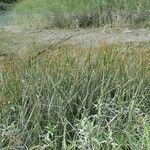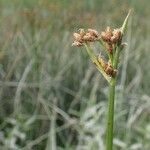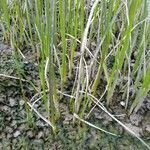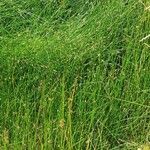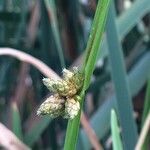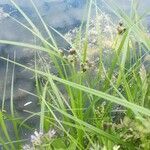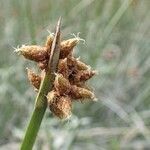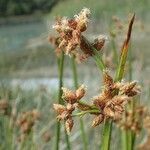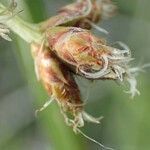Rhizomes 1.5–5 mm diam. Culms sharply trigonous, 0.5–1.5 m × 2–4 mm. Leaves 3–4, basal, smooth; sheath fronts not pinnate-fibrillose; blades 1 or 2, thickly V-shaped in cross section, to equaling sheath length. Inflorescences 1–2 timesbranched or subcapitate or of 1 spikelet, branches to 4 cm; proximal bract usually erect, trigonous, 2–7 cm. Spikelets 1–35, in clusters or solitary, 5–12 × 3–4 mm; scales straw-colored to orange-brown or midrib greenish, usually clearly lineolate-spotted, ovate, 3–3.5 × 2.5 mm, flanks ribless, midrib proximally spinulose, apex acute to rounded, notch 0.3 mm deep, awn 0.3 mm, sparsely spinulose. Flowers: perianth members 4–6, brown, bristlelike, equaling to less than 1/2 of achene body, retrorsely spinulose; anthers 2 mm; crest short, spinulose; styles 2-fid. Achenes brown, biconvex, ovoid to obovoid, 2–2.5 × 1.5–2 mm; beak 0.1–0.2 mm. 2n = 42.
Perennial herb, up to 1.52 m high, long-rhizomatous (occasionally tufted. Leaf blades on upper sheaths well developed, up to 120 mm long. Culm scapose, sharply 3-angled, 3-7 mm in diam. at middle. Inflorescence pseudolateral, head-like, of 1-10 spikelets. Subtending bract erect, appearing as a continuation of culm, longer than inflorescence. Spikelets elliptical, 6-12 x 5-7 mm. Glumes ovate, 3-4 mm long, keel excurrent into awn up to 0.5(-1.0) mm long. Style branches 2. Perianth of 3-5 retrorsely barbed, brown bristles, usually longer than nutlet. Flowering time July, Jan. Nutlet elliptical to obovate, excluding beak 2.2-2.8 x (1.2-)1.5-1.8 mm, plano-convex, greyish brown to blackish, surface minutely reticulate.
Perennial with triangular stems, to 1.5 m. Spikelets brown.
